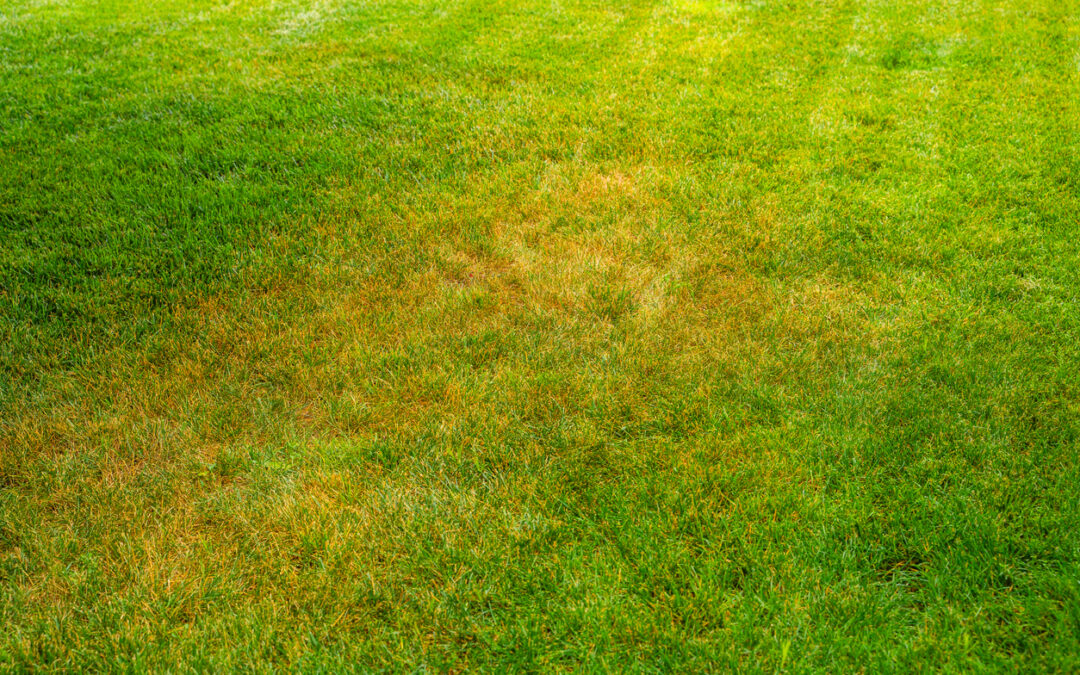By the time mid-to-late August rolls around, many Northern Maine lawns have taken a beating. Weeks of hot temperatures combined with dry conditions can quickly leave grass looking dull, brittle, or patchy. If your lawn is showing stress, you’re not alone—and the good news is there’s still time to help it bounce back before fall.
Here’s how to identify what your lawn really needs, how to adjust your watering practices, and why a carefully timed fertility boost can make all the difference.
Spotting the Cause: Drought, Pests, or Nutrient Deficiency?
Not every brown or thinning spot in your lawn is caused by drought stress. Before you dive into recovery efforts, it’s important to identify what’s really going on.
- Drought Stress: Grass blades may appear straw-colored, crunchy, and wilted. Footprints often linger on the lawn instead of springing back quickly. Entire sections may look dormant, but are often still alive at the root level.
- Pest Damage: Grubs, chinch bugs, or sod webworms can mimic drought symptoms. Unlike drought, however, pest damage often creates irregular patches that can be lifted or rolled back easily due to root feeding.
- Nutrient Deficiency: A lawn low in essential nutrients may turn pale green, yellow, or thin even if water is available. Deficiency stress is often gradual, spreading across larger areas rather than in isolated patches.
A professional evaluation can help confirm the issue so you can take the right corrective action. Misdiagnosis—like overwatering a pest problem—can make things worse.
Smart Watering Strategies for Summer Dry Spells

Water is the foundation of any lawn’s recovery plan, especially after extended dry spells. But not all watering is equal.
- Deep and Infrequent: Instead of light, frequent watering, aim for 1–1.5 inches of water per week delivered in deeper, less frequent sessions. This encourages turfgrass roots to grow deeper into the soil, improving drought tolerance.
- Timing Matters: Watering early in the morning (before 9 a.m.) reduces evaporation and allows grass blades to dry out during the day, which minimizes the risk of disease.
- Don’t Overdo It: Overwatering late in the season can create soggy conditions that invite fungal issues like brown patch. Moderation is key—keep the lawn hydrated, but not saturated.
If restrictions or natural rainfall make it challenging to provide enough water, prioritize high-traffic or most visible lawn areas to maintain curb appeal.
Fertility Boosts: Feeding Without Stress
After prolonged drought, your lawn’s root system and nutrient reserves are often depleted. A late-summer fertilizer application can help restore strength, but timing and formulation matter.
- Balanced Nutrients: A professional-grade fertilizer with balanced nitrogen, phosphorus, and potassium provides energy for recovery without pushing excessive top growth.
- Slow-Release Formulas: Slow-release nitrogen is ideal during late summer. It feeds steadily, avoiding the flush of tender growth that can increase stress or susceptibility to disease.
- Application Timing: Late August into early September is the sweet spot. The weather begins to cool, rainfall often increases, and grass naturally shifts its energy toward root development.
This targeted fertility boost not only revives current turf but also sets the stage for fall services such as aeration, overseeding, and winterization.
Beyond Recovery: Preparing for Fall Success

Reviving your lawn after summer drought is just the beginning. The transition into fall is the most important growing period of the year for cool-season grasses in Northern Maine.
- Aeration & Overseeding: Relieves compaction, improves oxygen flow to the roots, and creates the perfect seedbed for introducing new, drought-tolerant turf varieties.
- Continued Watering: Don’t stop watering once cooler weather arrives. Consistent moisture helps newly established roots grow deeper and stronger.
- Winter Prep: A final fertilizer treatment in late fall helps your lawn store nutrients for a faster spring green-up.
By giving your lawn the right care now, you’ll not only restore its summer appearance but also ensure it heads into winter healthier and better equipped for the year ahead.
Ready to bring your lawn back to life?
Late summer doesn’t have to mean giving up on a tired, stressed lawn. By correctly identifying problems, applying smart watering practices, and providing a well-timed fertility boost, you can revive your lawn after dry spells and set it up for long-term success.
At Northern Turf Management, we specialize in helping lawns recover from seasonal stress. Whether you’re dealing with drought, pests, or nutrient concerns, our team can design the right recovery plan for your property.
Contact Northern Turf today at 207-944-9420 for expert care and guidance. For additional lawn care and pest control articles, visit our blog!

